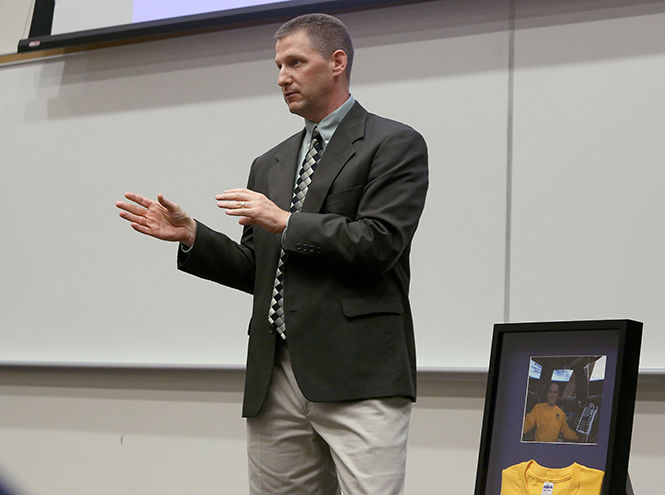Kent State T-shirt finds its way home from space station
Bruce Nieschwitz, Kent State athletic training alumnus and current NASA employee, presents the athletic deaprtment with a Kent State t-shirt that was given to an astronaut to wear in space at a reception Thursday, Oct. 2, 2014.
October 2, 2014
A Kent State alumnus presented an autographed T-shirt worn by a NASA astronaut to Provost Todd Diacon and Jeff Huston, director of the Athletic Training Program, before speaking at a seminar hosted by the athletic training program Thursday.
The alumnus, Bruce Nieschwitz, said the astronaut Kevin Ford wore the shirt during his expedition to the International Space Station from October 2012 to March 2013.
The shirt will be on the display in the M.A.C. Center Annex.
“(Ford’s) idea was, ‘If I had to take clothes up there to work out in and exercise in, then why not invite some people to give me one or two pieces of clothing that I can wear during orbit, take pictures in it so that they can have a memento of it,’” Nieschwitz said.
He then took the opportunity to donate the golden long-sleeved shirt, and to his surprise the shirt came back to Earth, which he presented to Huston and Diacon. Students of Kent State’s athletic training program, along with students from Mount Union and other universities and colleges, witnessed the presentation.
The shirt sat folded in a picture frame on display during the seminar as a form of inspiration for students to reach for their highest potential like Nieschwitz had.
The 1995 Kent State student graduated with a bachelor’s degree in human movement and minored in athletic training. He went to Mankato State University, now known as Minnesota State University, where he became a graduate assistant athletic trainer.
Before working at NASA, he also served as an outreach athletic trainer, an athletic trainer at Christus St. John’s Hospital-Sports Medicine in Nassau Bay, Texas, and as the head athletic trainer in the Alvin Independent School District in Alvin, Texas.
The opportunity to work for NASA was one that Nieschwitz took while working at Alvin High School. At first he was hesitant, but his wife, who already worked at NASA, told him to apply.
Now Nieschwitz is a part of one of NASA’s Astronaut Strength, Conditioning and Rehabilitation (ASCR) specialist groups at the Johnson Space Center in Houston. The groups of four members are either athletic or certified strength and conditioning trainers who work with astronauts with pre-flight conditioning and post-flight rehabilitation.
During the seminar, Nieschwitz informed students about the job of being an ASCR specialist. With a long list of duties, these specialists treat acute and chronic musculoskeletal injuries, educate their astronauts about musculoskeletal injuries, provide evaluations and manage cases.
In addition to informing students about how he and his team interact with their astronauts, Nieschwitz also talked about the equipment used during training sessions and the astronauts training schedule. He discussed what happens to astronauts’ bodies during their expeditions and how ASCR trainers and specialists prepare the astronauts before their flights and for rehabilitation after returning.
Throughout the seminar, Nieschwitz compared his work as an ASCR specialist to how students interact with student-athletes, conveying the difference between what he does and what they are learning how to do is not that different.
“The rehab protocol is pretty much the same as what we’re learning now in the program,” junior athletic training major Stephanie Golec said. “ You know, it’s about getting the athlete, or in this case the patient, back to their full go.”
During the seminar, students got the opportunity to see where their degrees could possibly take them. The experience opened many students’ eyes to the possibilities of expanding their careers beyond becoming sports physical therapists, specialist, and trainers.
Junior athletic training majors Alexis Chambers and Tristyn Clark agreed that the seminar with Nieschwitz dispelled the stereotypes of athletic trainers.
“It helped me learn about different areas that I can do as an athletic trainer, so I learned about varieties,” Chambers said.
The seminar also allowed students to see that they too can get into any field with a degree and become successful. They might even become an ASCR trainer like Nieschwitz.
“I’m just glad that he came and opened my eyes to see that I can do more things out there,” Chambers said. “You know when I first got here, I thought it was just high school and clinics, but now I see that I can do the military (and) the government jobs as an athletic trainer.”
Contact Joy TaMar Moorer at [email protected].












